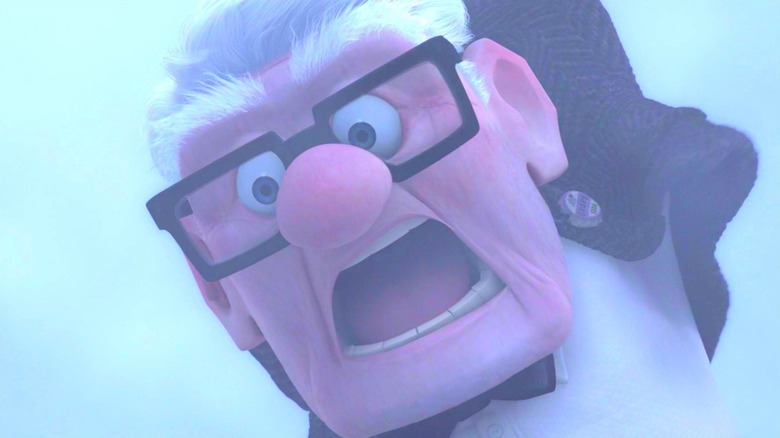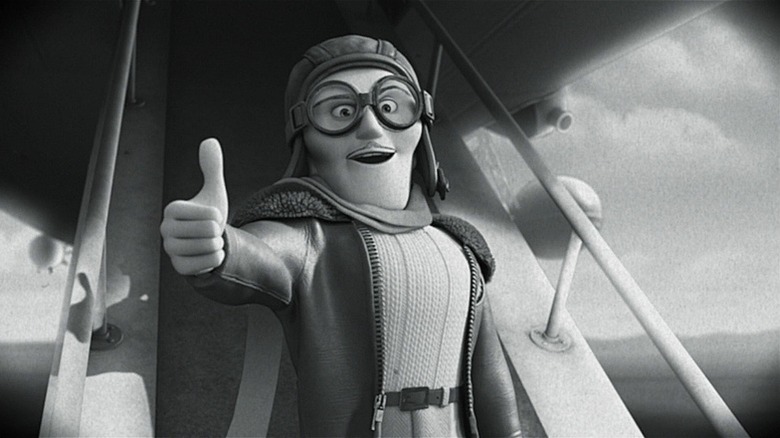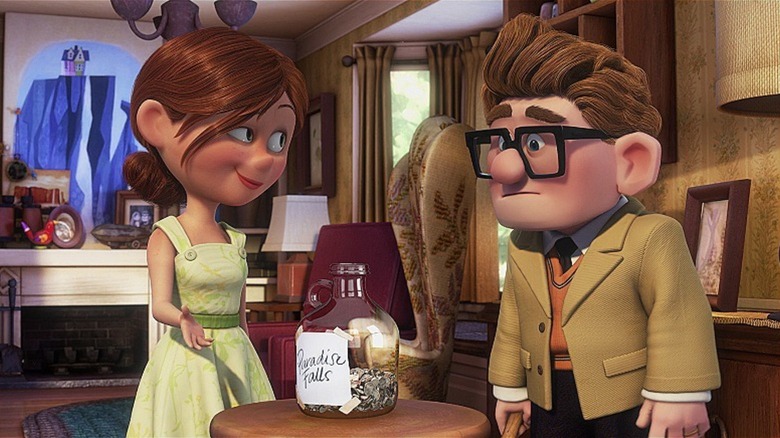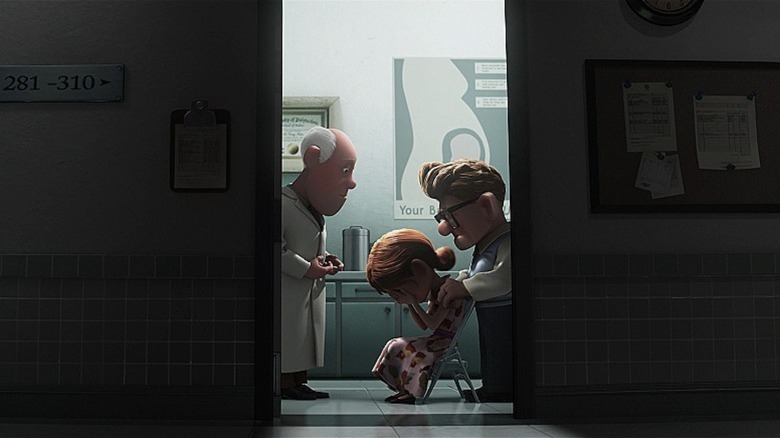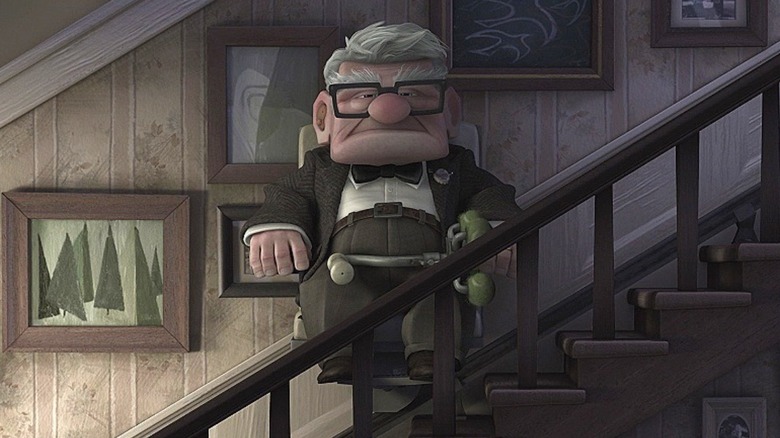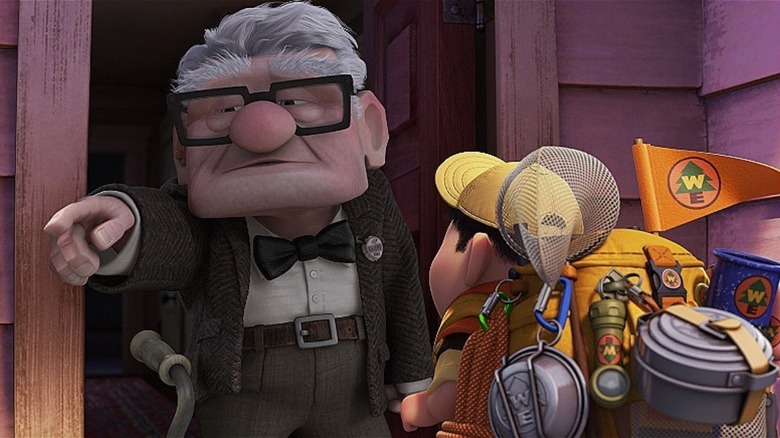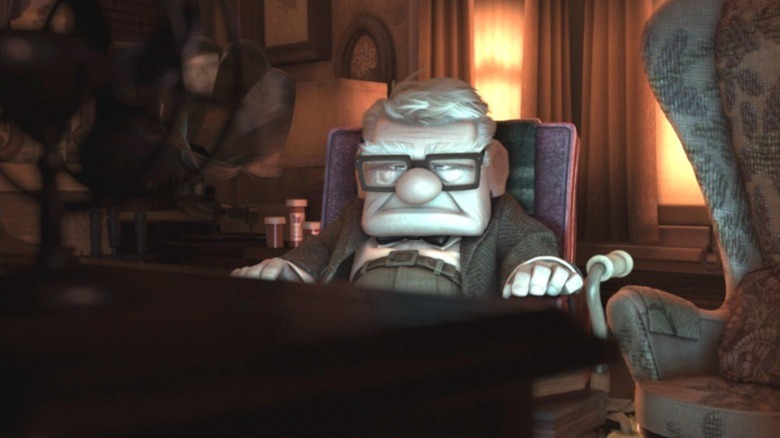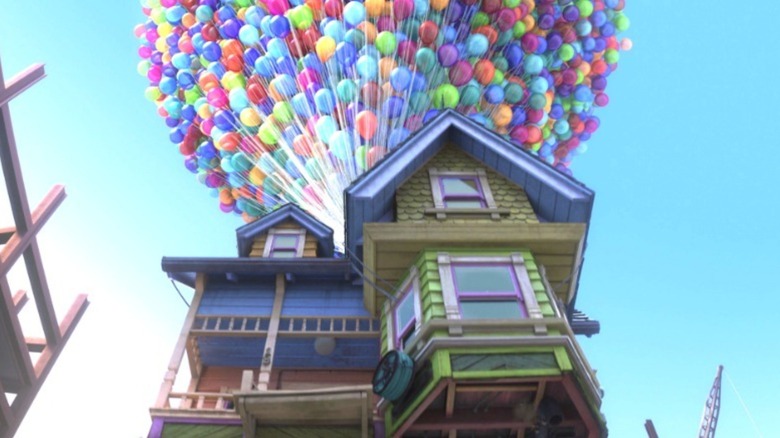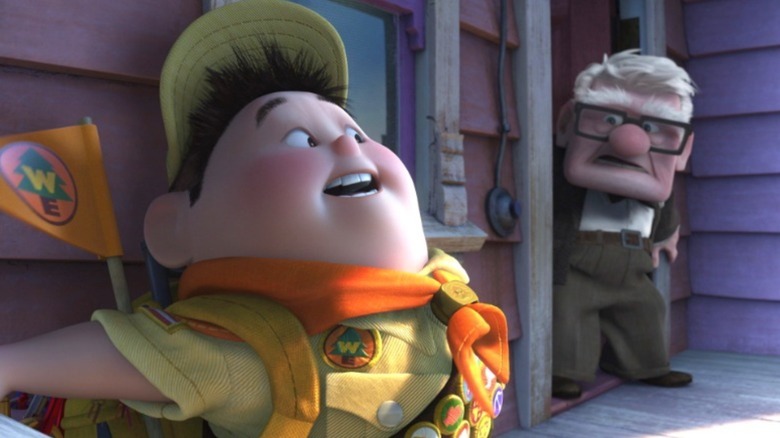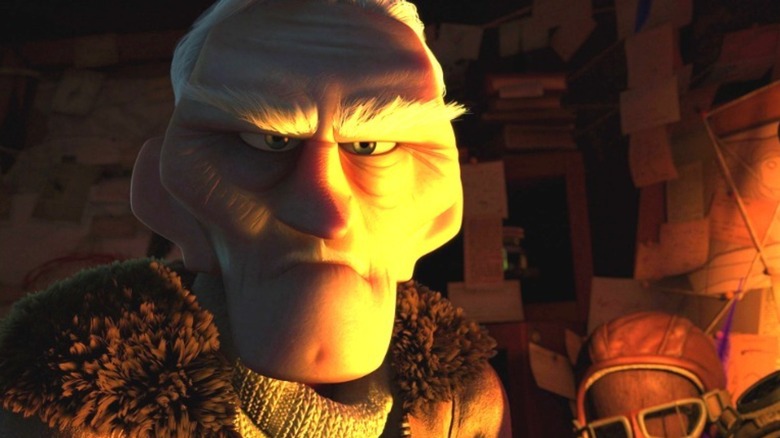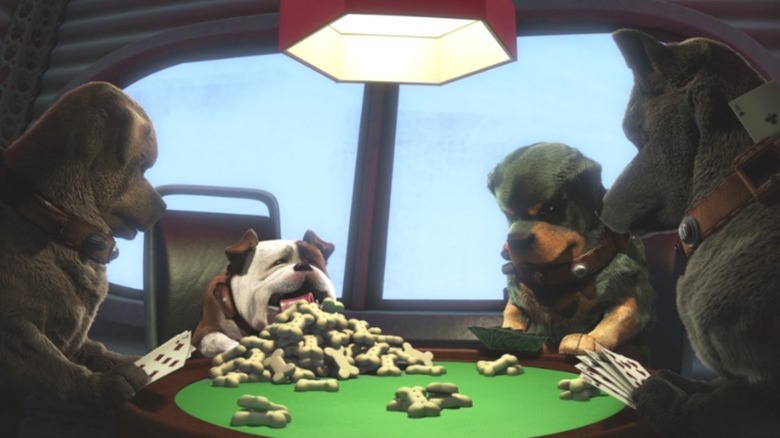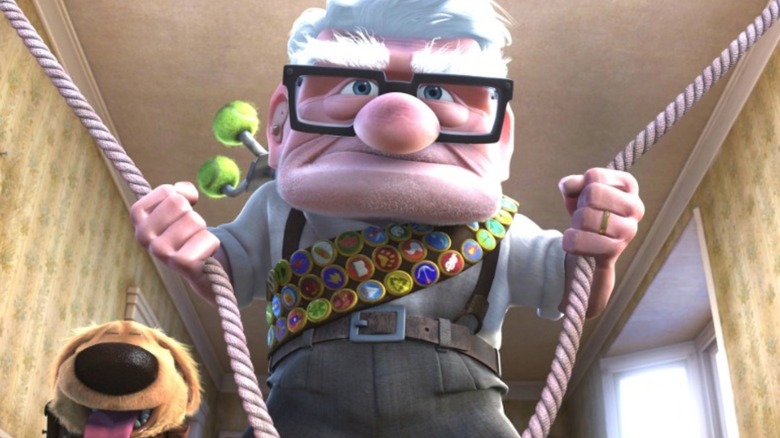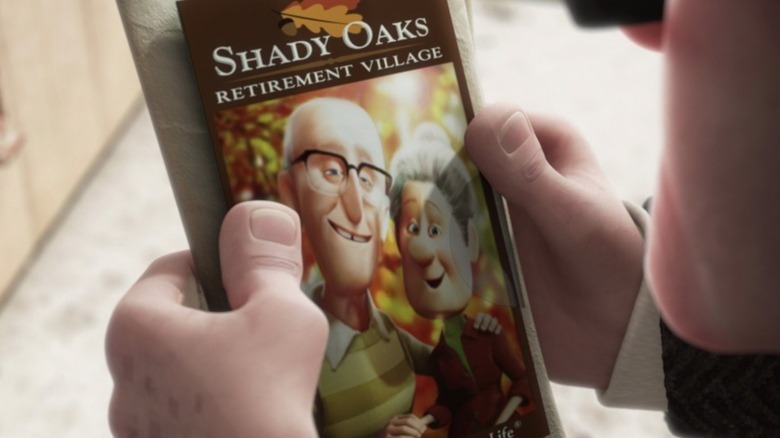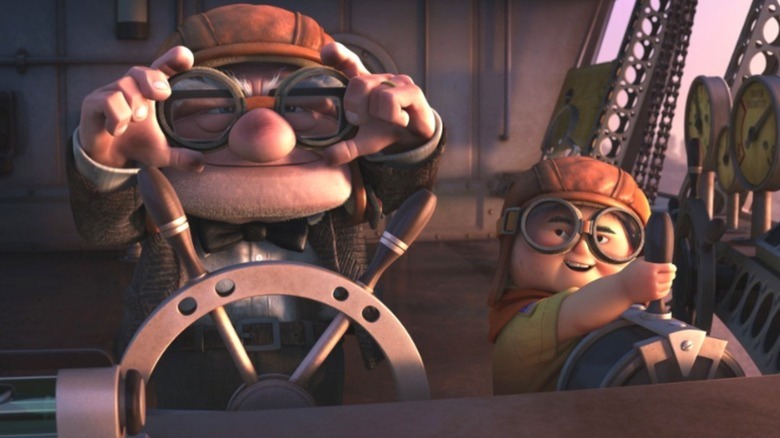Only Adults Can Spot These Details In Up
For decades, Disney and Pixar Animation Studios have put out some of the most memorable animated features in film history. Using groundbreaking animation technology to create original stories that entertain all ages, there seems to be no stopping this powerhouse collaboration. And with the advent of Disney Plus, there are now more ways than ever for viewers to enjoy the latest Pixar content — or to look back at some of their most popular classics.
One of the most beloved Pixar features that fans have revisited time and time again is the 2009 adventure comedy "Up." With over 20 years having passed since its original release, new generations of viewers are being introduced to the heart-wrenching and uplifting story of Carl Fredericksen (Ed Asner) and his magnificent flying house. As adults who grew up with "Up" watch the movie with their own kids, however, they might notice a few things they missed the first time around.
The newsreel in the movie theater
"Up" begins by introducing Carl and Ellie, two youngsters who bond over their shared love for adventure. Yet before they even meet, we see a 9-year-old Carl in a dimly-lit movie theater screening a black-and-white newsreel. Wide-eyed and filled with wonder, young Carl's gaze is glued to the screen as a crackling 1930s voiceover tells the story of famous adventurer — and Carl's hero — Charles Muntz (Christopher Plummer). The newsreel describes the rise and fall of the fearless explorer, which later comes into play in the third act of the movie.
Because the main plot of "Up" takes place in 2009, it's possible that its core demographic might not be aware of the historical reference being utilized at the beginning of the film. Today, movies in theaters are preceded by ads, behind-the-scenes sneak peeks, and trailers. In the early days of cinema, however, short documentaries featuring exciting current events were the norm. Of course, once televisions became available in most households, theatrical newsreels went the way of the dinosaur. It's likely that most kids — and honestly, even many adults — might be a bit out of the loop on this one.
Saving money is hard
Kids are often under the impression that adults have an endless supply of cash — they're the ones with the jobs, after all. They buy the food, the clothes, the toys, the wi-fi ... so why do they always claim that they don't have any money? They must be a bunch of liars, right?
"Up" provides a very good depiction of why this is not the case. In the movie's montage opening, Ellie and Carl can be seen dropping coins into a jar labeled "Paradise Falls," their dream vacation destination. Of course, they often must break the jar open to dig into their savings, because, well, stuff happens. Flat tires, hospital visits, and roof repairs are just a few examples of unpredictable expenses that grown-ups have to contend with. Sadly, these trials often mean that dreams and future goals have to be put on hold — if they even happen at all.
As the old saying goes, life is what happens while you're making other plans. Most adults know that those plans — and life — tend to cost a lot. Yet as "Up" also teaches, life's greatest adventures can also be had without ever spending a dime.
That opening montage really is heartbreaking
When most fans think of "Up," they think about the film's first heartbreaking 10 minutes. In that short period, we see a lifetime of memories flash before our eyes. What makes the scene even more moving is that it happens mostly without dialogue, using simple and relatable imagery to tug at the audience's emotions.
It's probably safe to assume that for most young people, the montage is just there to provide a backstory for Carl. Sure, there's some sadness to it, but it may be difficult for some younger viewers to understand why their parents are reaching for the tissues. And one moment of the sequence, in particular, might go a little over the heads of most kids.
While Ellie's death is certainly poignant, for many adults, it's the scene of her miscarriage that gets the tears flowing. Lots of kids may have had to ask the adult in the room to even understand what was happening. Losing a child before they're born is a painful undergoing, one that only those who have experienced it for themselves can ever know. Ellie and Carl's heartbreak is evident, but it's one that kids will have to grow up a little more to truly fathom.
The use of the Habanera from Carmen
Michael Giacchino's musical score has an undeniable presence in "Up." The lively theme in ¾ time is delightful in its simplicity, whether it's a lilting melody on the piano or the swell of a full orchestra. Giacchino (who would go on to produce the music for "Inside Out," "Coco," and "Incredibles 2") was the recipient of several awards and nominations for "Up's" score, including an Academy Award and a Golden Globe.
Along with the catchy theme song of "Up," however, there's another piece of classical music featured that will likely catch the ear of many — even those who are not necessarily music aficionados. After the opening montage turns the story over to the present day, we see 78-year-old Carl begin his morning routine. He gets out of bed, bones cracking, then goes downstairs for breakfast before doing a bit of light cleaning.
Though kids might recognize the piece of music that plays during the scene from countless cartoons over the decades, they are unlikely to know it by name. This is the Habanera (also known as "L'amour est un oiseau rebelle") from Bizet's "Carmen," or at least a wordless, orchestral version of it. While the themes of lust and jealousy in that famous 19th-century opera don't seem to fit the movie's depiction of Carl's daily routine, it's been observed that the use of the Habanera in "Up" is both subversive and effective.
The snipe hunt
Shortly after the audience sees Carl in his natural state, they are introduced to aspiring Senior Wilderness Explorer Russell (Jordan Nagai), a rambunctious 8-year-old who is trying to earn his "assist the elderly" badge and has his eye set on assisting Carl.
Unfortunately for Russell, Carl has no need of assistance and no patience for the well-meaning boy. To get Russell out of his hair, Carl asks for his help in tracking down a snipe that has been getting into his prized azaleas. Russell eagerly accepts the task, only to later learn the whole thing was a ruse.
Though the imaginary snipe hunt may be a new concept for kids, some adults may find it all too familiar. In fact, it's a tradition going back generations. Fans of the animated series "King of the Hill" may remember another reference to snipe hunting from the Season 1 episode "The Order of the Straight Arrow," in which the practical joke goes a bit too far. For Russell and Carl in "Up," however, the "snipe" becomes a wondrous aspect of their journey.
An early internet meme
An early scene in "Up" shows Carl relaxing in front of a glowing TV set before his respite is interrupted by Russell knocking on the front door. The audience doesn't have to see the screen to know what Carl is watching — even a few seconds of audio is enough to recognize a home shopping segment. Yet only adults (if they are paying close enough attention) may recognize the clip's audio from a famous viral video of the 2000s.
The particular clip that Carl is watching is a home shopping blooper video in which a man is promoting the sale of a high-quality camera. To demonstrate the camera's printer capabilities, he holds a giant, blown-up photo of a moth. He then states, very confidently, that the photo is a picture of a horse. "Look at that horse. The bushy tail, the big teeth, the hooves." It's only when the producer relays the truth to him off-camera that the host realizes his mistake — but by then the damage has been done, and the hilarious result was ripe for internet fodder.
Carl would need a lot more balloons to lift his house
One thing that Pixar and Disney do well is feed audiences' imaginations in unique and awe-inspiring ways. That's certainly the case with "Up" — when Carl's beloved home is lifted aloft by an array of colorful balloons and starts soaring through the air, viewers know that they are in for the ride of their lives.
As majestic as the sight is, however, many adults can't help but feel a stab of cynicism at the concept. According to Slate Magazine, Pete Docter, the co-director of "Up," said that the number of balloons estimated by their technician team to carry out such a feat is 23.5 million. However, animating that many balloons would have been far too daunting a task, so Pixar settled for just over 20,000 in the scene where the house first lifts off, and half that number in subsequent scenes.
While many have attempted to answer the question of how Carl's floating balloon house could actually work, one video from YouTuber Matthew Patrick delved deep, considering every potential factor from the house's building materials to the ratio of helium and mass weight. In the end, Patrick estimated that it would take approximately 31 million balloons to achieve the stunt in real life.
Where the heck are that kid's parents?
The relationship between Russell and Carl in "Up" begins with some tension. Russell wants to earn his scouting badge; Carl just wants to be left alone. Yet when Carl inadvertently takes Russell along with him on the journey to Paradise Falls, the two are stuck with each other. In time, a bond grows between them as Carl warms up to Russell's enthusiasm.
While it's great to see how Carl and Russell learn to get along with one another, any parents watching "Up" with their kids probably can't help but have a few questions — the big one being, where are Russell's guardians? Do they notice that he's missing? Surely they must be at least a little concerned when he doesn't come back home after an extended period of time.
Though we don't see much of Russell's parents, the movie provides a bit of information regarding his home life. His mother and father are likely divorced, or at least not together anymore. His dad isn't the most present parent and is seeing someone new. A woman we assume is Russell's mother appears at the end of the film during Russell's badge ceremony, yet doesn't seem the least bit phased that her son has been missing or give any indication that she even noticed his absence. These things could have happened off screen, of course, but a little more clarity would help to assuage concerned parents unconsciously clutching at their still-present but likely annoyed children.
Charles Muntz is named after Walt Disney's old rival
The antagonist of "Up" is the washed-up explorer Charles Muntz, who has made it his life's work to find a rare species of large bird he was once accused of fabricating and clear his good name. When he discovers that Carl and Russell are in the company of the female bird they've named Kevin, Muntz' greedy obsession turns to thoughts of murder. Muntz will do whatever it takes to claim his prize, even if it means he has to kill an old man and a small child to do it.
Muntz is clearly a bad guy, but what younger fans might miss is that the man whom he is named for was something of a Disney villain himself. In Walt Disney's early days as an animator, his distributor was a man named Charles Mintz. Mintz had a hand in commissioning Disney's first popular cartoon character, Oswald the Lucky Rabbit, but Mintz ultimately cheated Disney out of the ownership of Oswald and stole most of the Disney brothers' animation team, forming his own studio (which would later become Screen Gems). Unfortunately for Mintz, Oswald the Lucky Rabbit isn't well-remembered today — and Disney soon created another character whose popularity would make his company the world's most powerful media empire. The Walt Disney Company purchased the rights to Oswald in 2006.
Dogs playing poker
Some jokes never get old, and a bunch of dogs playing poker is one of those timeless classics. During the climax of "Up," Russell and Carl's bird friend, Kevin, is captured by the dastardly Charles Muntz. When Carl refuses to help, Russell fearlessly takes on the mission by himself, mounting a leaf blower held aloft by a bouquet of balloons. Against all odds, Russell makes it to Muntz's giant zeppelin, the Spirit of Adventure, with Carl close behind after a change of heart.
As Russell approaches the Spirit of Adventure, he is spotted by Muntz's guard dogs through the window. The pack is in the middle of a card game, with one bulldog in particular seeming to have won the jackpot of doggie treats. This is, of course, a funny visual gag, but kids probably didn't get the cultural reference — it's a nod to a famous series of American paintings: "Dogs Playing Poker," by Cassius Marcellus Coolidge.
Coolidge created 18 paintings for his iconic series, the most recognizable being "A Friend in Need," which was painted in 1903. The artwork depicts seven dogs of various breeds sitting around a poker table and holding cards. One of them even has an Ace of Clubs hidden away, just like one of the dogs in "Up."
Carl is pretty spry for a 78-year-old
When we first meet Carl Fredericksen, we are keenly aware of his age. We've seen him live a full life — he met Ellie, got married, endured both joy and heartache, and was ultimately left alone in the house he built with the love of his life. He's 78-years-old when the true story of "Up" begins, making him the oldest protagonist in a Disney Pixar film so far.
Even more impressive, considering this, are the physical exertions that Carl pulls off during his adventures with Russell when they reach their destination in South America. He can be seen trekking through dangerous terrain, riding on the back of a giant bird, and zip-lining possibly thousands of feet in the air. Even adults decades younger than Carl might feel their bones aching as they watch him pulling off these dangerous stunts.
One particularly hilarious scene does show Carl's age catching up with him when he faces off against Charles Muntz. Both men groan in pain as they struggle to melee with the other, reminding them that they are not as young as they used to be.
Carl actually did end up in the retirement home
Marvel movie end credits are known for their sneak peeks and easter eggs, but Disney and Pixar also have their little secrets as well. Watch the end of "Up" and you'll see a few.
At the beginning of the movie, Carl collects his mail and finds a brochure for Shady Oaks Retirement Home. He scoffs at the literature, clearly not even considering assisted living to be an option. However, he is forced to leave his home after attacking a construction worker and presumably losing a court battle. Two retirement home employees show up at his door to escort him to his destination, but he manages to escape their clutches.
After Carl and Russell return home from their adventures, audiences can get a glimpse of a few of their outings via scrapbook photos in the end credits. They can be seen picnicking on a hill, visiting a museum, and chasing after a squirrel-hunting Dug. There is also a photo of the two of them with the elderly folks at what is likely Shady Oaks. The dogs from Muntz's crew enjoy quality time with the residents, and it appears that Carl also feels quite at home. With his own house now overlooking Paradise Falls, it looks as though Carl may have decided that assisted living wasn't such a bad idea after all.
Carl finds his new spirit of adventure
From the film's opening scene to the roll of the end credits, the theme of "Up" is abundantly clear: Adventure is out there, and — despite what kids might think — life doesn't end when you're old. For Carl, his first adventure began when he met Ellie in the abandoned house in his neighborhood. That adventure continued when he and Ellie wed, though it came to a sad end at her death. However, as Carl soon learned, his own adventures were far from over. Instead of accepting a quiet and mundane life in his twilight years, he decided to seize the day and go on his very own journey of discovery and wonder.
Just like Carl as a young boy, everyone at one time in their lives has felt the need for adventure — whether it's playing pretend in their backyard or seeing the world. And just because people get older, doesn't mean they lose that spark and lust for life. As Carl learns throughout his time in "Up," adventure is indeed out there and can be found in many places. Marriage is an adventure. Life is an adventure. And you're never too old to hold onto that childlike awe and go out and seek it for yourself.
